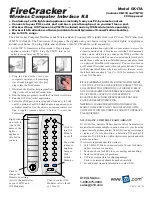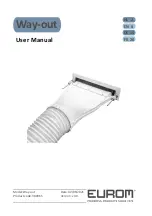
Service & Maintenance
GE, GX Series
Backhoe
36
8. Service & Maintenance
CAUTION!
Do not risk injury by working in an unsafe
situation. Take steps to make the machine safe to
work on before performing any maintenance or
service procedure.
Follow steps listed to put the machine in a Safe
Condition.
W049
Safe Condition
•
Install boom and swing lock pins, or rest bucket on
ground.
•
Shut off hydraulic system.
•
Set parking brake and shut off engine. Remove ignition
key.
•
Ensure all components have stopped moving.
•
Block or chock wheels.
8.1 Maintenance Safety
•
Have at least two workers present when performing
maintenance on this equipment. Never work alone in case
an emergency should arise.
•
Keep service area clean and dry.
•
Never operate the engine in a closed building. Make sure
there is plenty of ventilation. Exhaust fumes can cause
asphyxiation.
•
Never work under unsupported equipment.
•
Use only genuine OEM replacement parts. The
manufacturer is not responsible for injuries or damage
caused by the use of non-approved parts or accessories.
•
Make sure all safety shields and devices are re-installed
when a maintenance or service procedure is finished.
•
Do not use gasoline or diesel fuel when cleaning any parts.
Use a regular cleanser.
•
Use proper tools that are in good condition. Make sure the
procedure is understood before performing any service
work.
8.1.1 Hydraulic System Safety
•
Make sure that all the components in the hydraulic system
are kept clean and in good condition.
•
Make sure all components are tight, and that lines, hoses
and couplings are not damaged before applying pressure to
the system.
•
Do not use your hand to check for
hydraulic oil leaks. Hydraulic fluid
escaping under pressure can penetrate
the skin causing serious injury. Use a
piece of cardboard.
•
Wear proper hand and eye protection
when searching for a high-pressure
hydraulic leak.
•
Seek medical attention immediately if injured by a
concentrated high-pressure stream of hydraulic fluid.
Serious infection or toxic reaction can develop from
hydraulic fluid piercing the skin surface.
•
Do not attempt any makeshift repairs to the hydraulic lines,
fittings or hoses by using tape, clamps or cements. Doing
so can cause sudden failure and create a hazardous and
unsafe condition.
•
Relieve pressure on the hydraulic system before working
it. The hydraulic system operates under extremely high
pressure.
•
Replace any hydraulic hose immediately that shows signs
of swelling, wear, leaks or damage before it bursts.
•
Do not bend or strike high-pressure lines, tubes or hoses,
or reinstall them in a bent or damaged condition.
•
Check to make sure hydraulic hoses are not worn or
damaged, and are routed to avoid chafing.
•
Never adjust a pressure relief valve or other pressure-
limiting device to a higher pressure than specified.













































